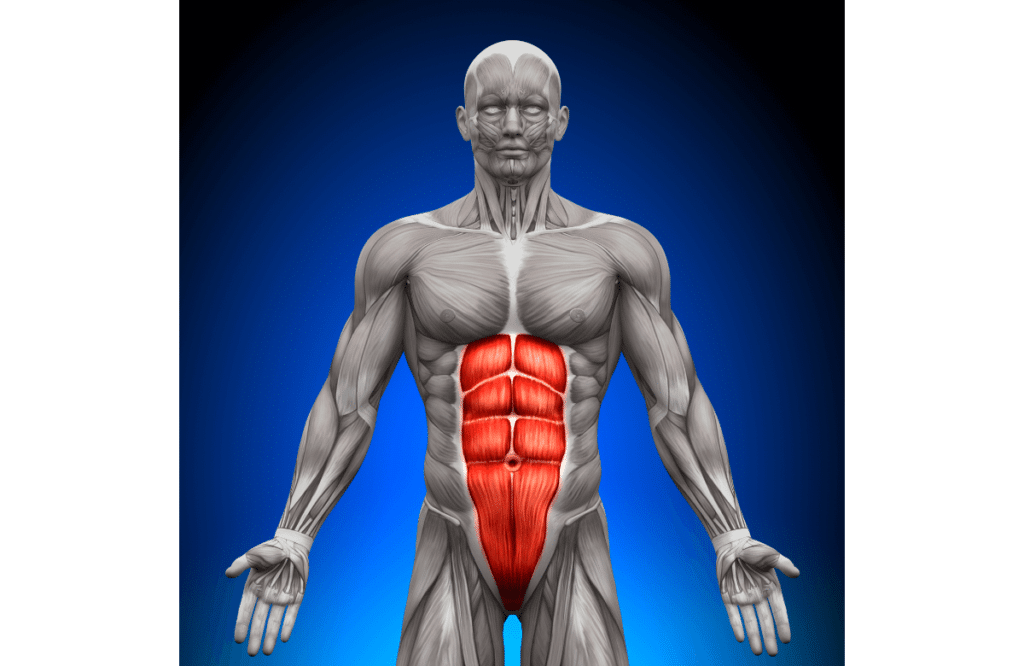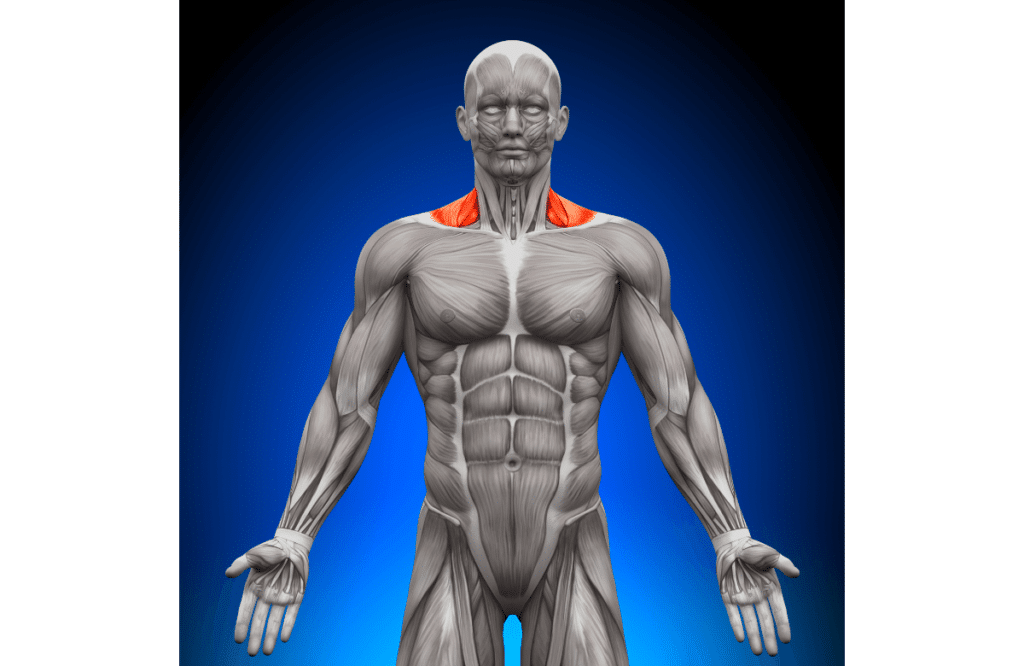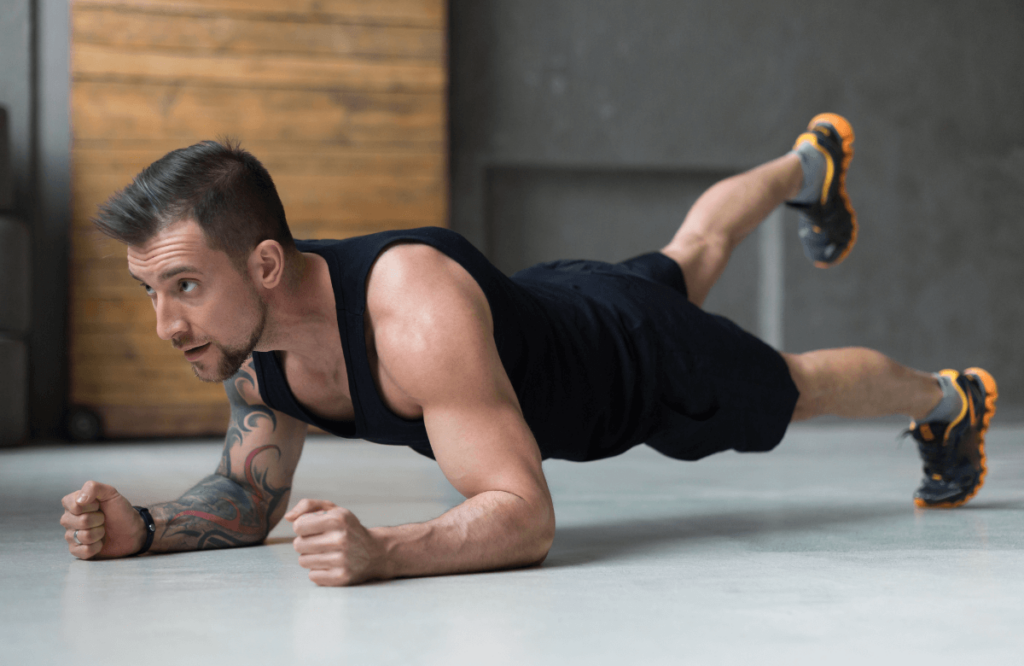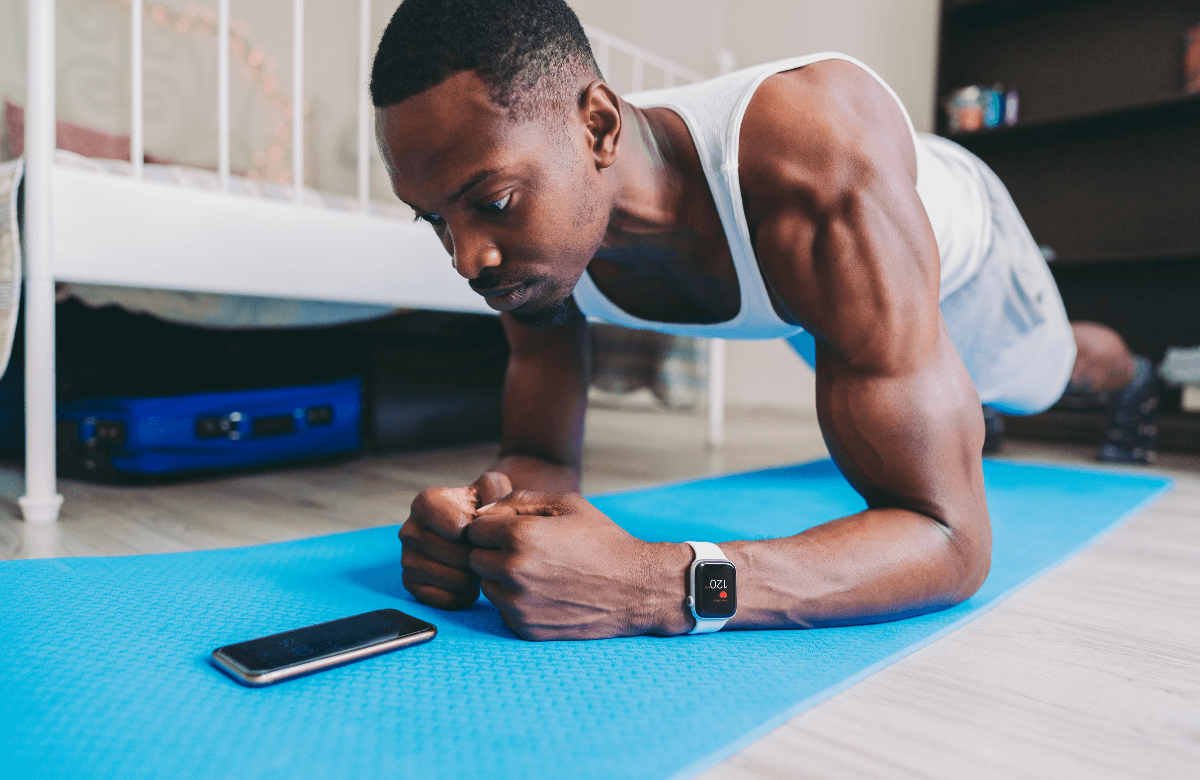The core is the foundation of a strong physique, it helps balance and stabilize your body throughout any workout regimen. The plank is one of the best core exercises you can do, and it’s scalable at virtually every fitness level.
But you can’t just jump in and expect all the benefits of a stronger core, like a toned six-pack, to happen. You’ve got to do it right if you want results.
In this article, I’ll explain what you need to know about the plank, correct technique, benefits, and best variations so you can carve your core every time.
Jump to:
What are Planks?
A regular plank is performed on the floor in a push up position while resting on your forearms. It’s a classic addition to any workout regimen because it doesn’t need much setup, space, or equipment, and provides a ton of benefits. This challenging isometric exercise (engaging muscles without any movement) is a safe and effective core strengthening exercise.
The Plank: Form And Technique
How to do a plank:
- Begin by getting down onto the ground. Place your elbows directly beneath your shoulders with your forearms outstretched. Extend your legs and plant your toes on the ground.
- Focus on distributing your weight between your elbows and toes. Then, squeeze your glutes and core muscles so your body becomes rigid and straight like a plank of wood. Don’t let your hips sag or your butt rise.
- Think about sucking your belling button up into your spine, and tighten your rhomboids, lats, and lower back so everything all locks into your core.
- Keep your eyes on the floor, this keeps your spine neutral.

Engage Your Whole Body
While the plank is a full-body exercise, it primarily works the abdominal muscles. You need to focus on targeting your abs throughout the workout. Keep your core tight, flex your abs, and feel them working. Think of your abs as holding your rib cage together. This way, you’ll engage your entire core complex and activate the right muscles.
By making your whole body rigid, you’re creating full-body tension. Focus on keeping your forearms rigid, drive through your elbows to your shoulders, and maintain tension in your shoulder blades. Activate your core and squeeze your quads to straighten your knees. This is going to develop strength throughout your whole body.
How Long Should You Hold A Plank?
This is a common question and it depends on your fitness level. In general, it’s best to aim for 20-30 seconds in the beginning and work your way to a longer hold. You might only want to hold for 10 seconds at a time if you have lower back pain. If you want endurance, aim for the higher end of two minutes. It’s better to perform short bursts with good form than a five minute plank with poor form.
Longer planks can do more harm than good. Creating tension is the entire aim of the exercise. Most people can only hold a plank correctly for two minutes. After that form deteriorates and you’re no longer holding tension in your muscles. Planking for one minute at a time is enough to build strength and torso resilience.
How often should you do planks?
You might not need to perform a plank every day. For muscle growth, deadlifts, pull ups or the bench press might be a better use of time. In general, performing a plank every three to four days can benefit your body in many other ways. You might not get an instant six-pack, but you’ll feel healthier and fitter. But pay attention to your muscles, take a rest if your abdominals feel overworked.
Muscles Worked
Although your whole body is engaged, the plank primarily targets the core, which is made up of several muscle groups including your abdominals, back, hips, pelvis, and buttocks.
Abdominal Muscles

In particular, the plank targets your abdominal muscles, such as your rectus abdominis, obliques, transverse abdominis, and erector spinae.
Lower Body Muscles

During the plank, you’ll hit your lower body muscles such as your quadriceps and gluteal muscles, including the gluteus medius and gluteus maximus. Your gastrocnemius (calf muscles) also switch on, as well as your hamstrings.
Upper Body Muscles

Upper body muscles engaged include the trapezius, rhomboid major and minor, latissimus dorsi, pectorals, anterior medial and posterior deltoids, biceps, and triceps.
Benefits of Planks
What Do Planks Help With?
The key benefit of the plank is the bracing that happens when you tense your body. This is what helps your body perform deadlifts and overhead squats, to daily activities like picking something up off the ground. Research has found a strong core can lower blood pressure, reduce stress on the joints and allow you to achieve better posture.
What Results To Expect?
Studies have proven planking is an excellent exercise for overall health. The National Library of Medicine found that consistent high-intensity planking over four weeks led to an increase in overall physical fitness, including muscle strength, endurance, and flexibility, basal metabolic rates were increased, while body fat mass and percentage were decreased.
Reduces Belly Fat
The plank focuses more on core and overall strength and stability, rather than cardio. But they are still a great option for toning the stomach because they engage multiple muscles at once, increasing metabolic rate and muscle growth. This increases calorie burning while you rest. Most people can expect to burn around two and five calories per minute during a plank.
Strong Core
Any weightlifting workout requires a strong core, it all begins there. It’s going to help keep your form during heavy lifts and improve stability and balance through cardio workouts like running or jumping. But outside of the gym, a weak core can cause all kinds of physical issues.
The biggest complaint is lower back pain. That’s because the back muscles and the core stabilize the muscles. If your core is weak, it can put your body out of alignment as your other muscles are forced to compensate, causing muscle strain and pain. This can lead to poor posture, shoulder and neck pain, and even hip and knee aches.
Think of your core as the foundation of your body. You’ll have a stronger chance of reducing injury and bad posture throughout your life if you give it the attention it deserves. The plank is a quick and relatively easy way to continually strengthen your core.
Common Mistakes When Doing Planks
Neglecting The Abs
This is a core exercise so you want to focus on the abs. To activate the spine stabilizers, tighten your belly button and pull it into your spine so your body is all in one straight line. If you forget to focus on the abs, the plank loses most of its efficiency.
Forgetting To Activate The Glutes
When this happens, it leads to one of the most common mistakes in the plank, where the butt is the highest point of the plank. As a result, the back of the body loses that straight line. By squeezing the glutes the entire time, you’ll get into a neutral position which will keep your alignment.
Arched Back
If your back is arched that means your abdominals aren’t engaged. Your arms, rather than your core, will take the brunt. Ensure that you’re setting up correctly. Rest your elbows comfortably under the shoulders, and then step your legs back so they are fully extended.
Sagging Hips
You’ll notice your hips start to sag when your core has reached the fatigue limit in the plank. That’s when you’ll want to take a rest. It’s good to note this time as this is potentially a benchmark you can work on improving.
Head Out Of Alignment
Keep your neck in a neutral position with the spine. If it becomes out of alignment, you can risk strain or injury. Focus on the floor below you.

Best Plank Modifications And Variations
The plank is scalable depending on your fitness level. You can easily regress the exercise in a couple of ways. You can simply hold the plank for less time. Another option is to do the plank on your knees, this can be a good option for those in rehabilitation. For experts looking for a greater challenge, here are the best plank variations to work your core even harder.
High Plank
The high plank, or full plank, requires more strength than the traditional forearm plank, hence you’ll want to master the proper technique before you try this option. It’s a logical progression when you’re wanting to move up to more challenges such as adding weight plates or performing the plank on unstable surfaces like fitness balls and stability balls.
- Start in a tabletop position on your hands and knees, then step your feet back so they are fully extended, like the start of a push up.
- Keep your glutes, quadriceps, and core tight. Don’t sag.
- Remain in a nice straight line from your ankles to your shoulders.
- Hold the position for set amounts of time or as long as you can retain proper form.
Plank Reach Around
The plank reach around is a variation that requires greater core stabilization and balance. The key is to keep your hips straight and your core engaged as you move your arm up and around to different positions.
- Begin in a forearm plank.
- Reach one arm up in the air, and then extend it out away from you and tap your fingers on the ground.
- Reach back to tap near your feet (or as near as you can).
- Reach back out to the side, then reach forward in front of your body, touching your fingers on the floor again.
- Return to the starting position by reaching out to the side, and repeat the movements.
Side Plank
This version targets the entire core, including the obliques which help shape and tone your waistline and lower back. It requires extra balance as you work to keep your hips and core in alignment. You can regress this move by lowering onto your forearms.
- Begin in a side plank position.
- Plant your hand down, dig the sides of your feet into the floor, and activate your core as you lift.
- Lift your arm in the air so the front of your body is completely open, you can choose to look up towards your hands.
- Hold as long you can remain in proper form or for a set amount of time, repeat on the other side.
Knees to elbow
Knees to elbow differ from the standard isometric plank. This variation involves dynamic movement which puts an extra strain on the core.
- Begin in a regular plank position, using your forearms for balance.
- Ensure your body has the correct form, don’t arch your back.
- Bring your left knee up to your left elbow (or as near as possible).
- Straighten your leg and return your foot to the floor, repeat on the other side for a set amount of time.
Alternating Superman Plank And Reach
This variation is an intermediate to advanced isometric training exercise. All the benefits of the forearm plank are enhanced as this requires serious balance and core stabilization.
- Get into an elevated push up position, brace your core and contract your glutes and quads.
- Slowly, raise your left foot and then your right arm off the floor and hold. Try to keep your body in a straight line.
- Lower each limb and return to the floor, then repeat the move on the opposite side for a set amount of time.
Reverse plank
You want to get comfortable with the regular plank before moving on to the reverse version. This move is made more difficult because it engages your upper and lower back, as well as your glutes and abs. Start by holding for just a few seconds at a time and be mindful of any pain or discomfort. You can make it even more challenging by adding a weight plate to your abdomen.
- Begin by sitting on the floor with your legs extended.
- Place your hands behind you in whatever direction feels most comfortable, keep your palms flat on the ground and your fingers spread wide.
- Point your toes towards the floor and raise your hips off the ground until your body is in a straight line.
- Keep your arms straight, and look up to the ceiling.
- Contract your core muscles and aim to pull your stomach in towards your lower back.
- Hold as long you can remain in proper form or for a set amount of time.
Weighted Plank Hold
Adding a weight plate is a higher-intensity plank exercise. It’s best to start with a low weight before working up to a higher load. Having someone place the weight on your back while you’re already in position is ideal, but you can still do it yourself.
- Sitting on your knees, roll the plate around to the back of your body and hold it with both hands behind you.
- Lean forward and slide the weight up until it is on the upper part of your back, then place each elbow down on the ground one at a time.
- Finally, step your feet back with your abs squeezed tightly. When you’re done, drop down onto your stomach and gently roll sideways so the plate slowly slides off your back.
Frequently Asked Questions
How long should a beginner hold a plank?
When you’re first starting, aim for multiple sets of shorter times. Performing the plank in bursts of 10 to 30 seconds is enough. Focus on maintaining proper form and work up to longer planks of one to two minutes. Anyone with back pain should aim for 10 second bursts.
Is a 2 minute plank a day enough?
How often and how long you plank depends on your fitness level and goals. You don’t need to hold a plank long to reap the benefits. Many experts agree the ideal length of time is around two minutes. It’s more important that you can hold maximum tension in your core. For most people, that’s around one to two minutes.
Can planks reduce belly fat?
While it’s not a cardio workout, the plank is a common exercise to help burn belly fat and help you get a flatter, more toned stomach. Compared to crunches which only target the abs, the plank targets your entire core region. As a bonus, this increased muscle offers more calorie burning while you rest. However, a run or cycle is better for weight loss.















